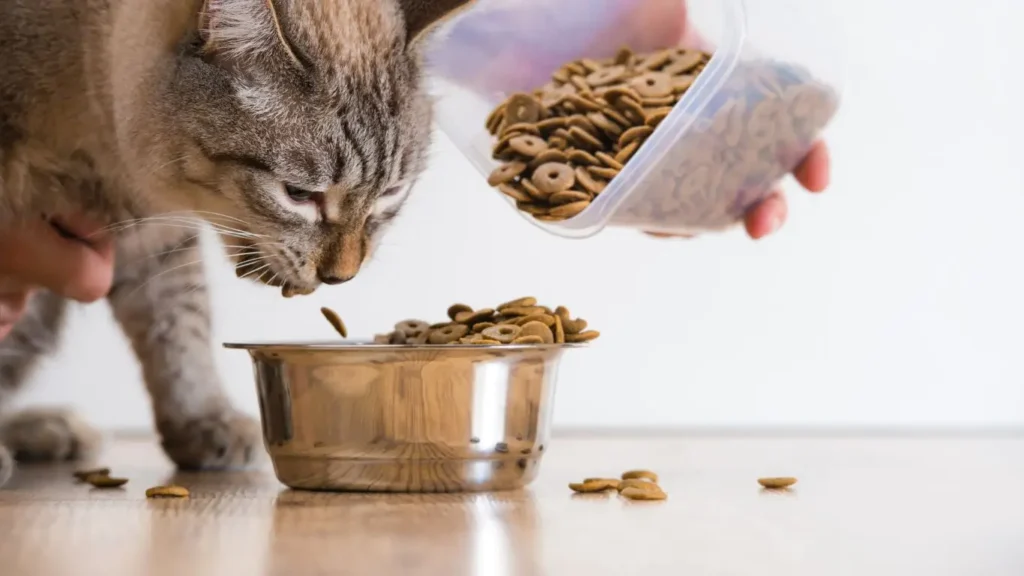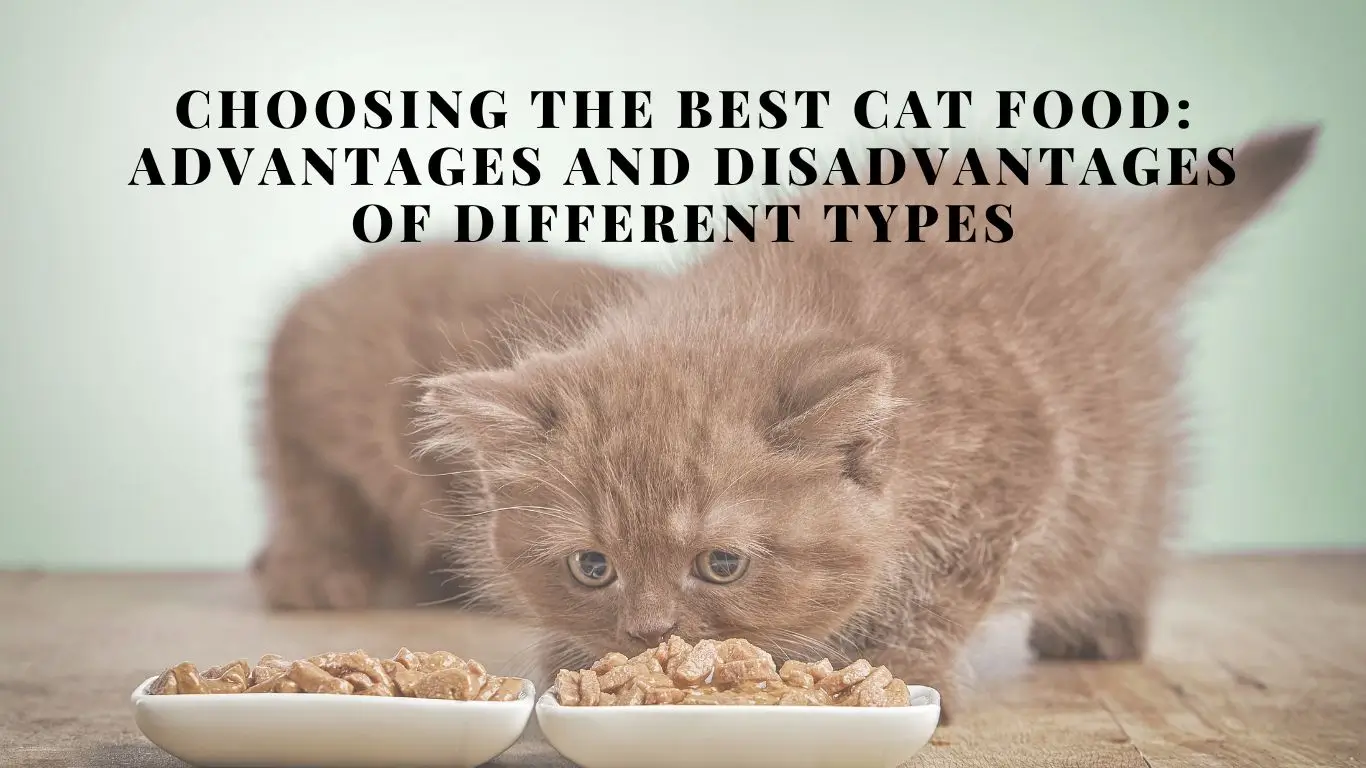A well-balanced diet is essential for keeping your cat healthy, energetic, and happy. With so many types of cat food available on the market, choosing the best one can be overwhelming.
Each type of cat food—dry, canned, and semi-moist—comes with its own set of benefits and drawbacks. In this guide, we’ll explore these different types of cat food, along with their advantages and limitations, to help you make an informed decision for your feline companion.
Understanding Different Types of Best Cat Food

Cats are obligate carnivores, which means they require a diet primarily based on meat to thrive. Their nutritional needs include high levels of protein, moderate fat, and minimal carbohydrates, along with essential vitamins and minerals. The three main types of commercially available cat food are:
- Dry cat food (kibble): Contains low moisture content and is widely available.
- Canned cat food (wet food): Has high moisture content and often mimics a cat’s natural diet.
- Semi-moist cat food: Offers a balance between dry and wet food but is less common.
Each type of cat food has its own advantages and limitations. Understanding these differences can help cat owners choose the best option for their pets.
What Are the Advantages and Limitations of Dry Cat Food?
Dry cat food, commonly known as kibble, is one of the most popular choices among pet owners. It comes in a variety of flavors and formulations, making it a convenient and cost-effective option. However, while it has several benefits, it also has some limitations that cat owners should consider.
Key Benefits of Dry Cat Food
- Convenience and Shelf Life
- Dry cat food is easy to store and has a longer shelf life compared to wet food.
- It can be left out for longer periods without spoiling, making it ideal for free-feeding.
- Cost-Effective
- Kibble is generally more affordable than canned or semi-moist food.
- It can be bought in bulk, making it a budget-friendly option.
- Dental Health Benefits
- The crunchiness of kibble helps reduce plaque and tartar buildup.
- Some dry foods are specially designed to promote oral health.
- Nutritional Variety
- Many dry cat foods are fortified with essential vitamins, minerals, and probiotics.
- Special formulations cater to specific dietary needs, such as weight management or urinary health.
Potential Drawbacks of Dry Cat Food
- Low Moisture Content
- Dry food contains only about 10% moisture, which may not provide enough hydration for cats.
- Cats that consume only kibble may be prone to dehydration, urinary tract issues, and kidney problems.
- Higher Carbohydrate Content
- Many dry foods contain fillers like grains, corn, and potatoes, which can lead to obesity and diabetes in cats.
- Cats require a high-protein, low-carb diet, which some dry foods may not provide.
- Picky Eaters May Not Prefer It
- Some cats may not find dry food as appealing as wet food due to its texture and smell.
- Difficult for Senior Cats
- Older cats with dental problems may struggle to chew dry food.
What Are the Advantages and Limitations of Canned Cat Food?

Canned cat food, often referred to as wet food, is another popular choice among cat owners. It contains a high moisture content and typically offers high-quality ingredients that closely resemble a cat’s natural diet.
Benefits of Choosing Canned Cat Food for Your Feline
- High Moisture Content
- Canned food contains around 70-80% moisture, which helps keep cats hydrated.
- Hydration from wet food can support kidney function and reduce the risk of urinary tract infections.
- Rich in Animal Protein
- Most wet foods have a high meat content, which aligns with a cat’s natural dietary needs.
- They often contain fewer carbohydrates compared to dry food.
- Palatable and Appetizing
- Cats love the texture and aroma of canned food, making it an excellent choice for picky eaters.
- It’s particularly useful for senior cats or those with dental issues who have trouble chewing kibble.
- Lower in Carbohydrates
- Many canned foods contain little to no fillers, making them a healthier option for weight management.
- They help prevent obesity and diabetes in cats by providing a protein-rich diet.
Limitations and Considerations with Canned Cat Food
- Shorter Shelf Life
- Once opened, canned food must be refrigerated and used within a few days.
- It cannot be left out for long periods, as it spoils quickly.
- Higher Cost
- Wet food is generally more expensive than dry food, especially if fed exclusively.
- Regular feeding of canned food can become costly for multi-cat households.
- Messier and Less Convenient
- Serving wet food requires opening cans, portioning meals, and refrigerating leftovers.
- Some cats may not finish their portion in one sitting, leading to food wastage.
- Can Contribute to Dental Issues
- Unlike dry food, canned food does not help clean a cat’s teeth.
- Regular dental care is necessary for cats that eat wet food exclusively.
What Are the Advantages and Limitations of Semi-Moist Cat Food?
Semi-moist cat food is less common than dry or canned food but offers a middle ground between the two. It contains more moisture than kibble but less than wet food, making it appealing to some cats.
Pros of Semi-Moist Cat Food for Your Cat
- Higher Moisture Content Than Dry Food
- Semi-moist food contains around 25-35% moisture, providing better hydration than kibble.
- It can be a good option for cats that dislike canned food but need more moisture in their diet.
- Soft Texture for Easy Chewing
- Its chewy consistency makes it easier for senior cats or those with dental issues to eat.
- It provides a more palatable option for picky eaters who dislike kibble.
- More Convenient Than Canned Food
- Unlike wet food, semi-moist food does not require refrigeration.
- It is easier to store and serve compared to canned cat food.
Cons and Challenges with Semi-Moist Cat Food
- Contains More Artificial Additives
- Many semi-moist foods contain preservatives, artificial colors, and flavor enhancers.
- Some brands use high amounts of sugar or salt, which are unhealthy for cats.
- Higher Cost with Limited Availability
- Semi-moist cat food is often more expensive than dry food and may not be widely available.
- Not all brands offer semi-moist options, limiting choices for pet owners.
- Shorter Shelf Life Than Dry Food
- Although it lasts longer than canned food, semi-moist food still has a shorter shelf life than kibble.
Conclusion
Choosing the best cat food depends on your cat’s dietary needs, health condition, and personal preferences. Dry food is cost-effective and convenient but may lack moisture.
Canned food is rich in protein and hydration but can be expensive and less convenient. Semi-moist food provides a balance but may contain artificial additives.
For optimal health, many veterinarians recommend a combination of dry and wet food to provide variety and balanced nutrition. Always consult your vet before making any dietary changes to ensure your cat receives the best possible care.

